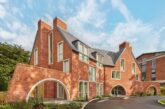
Maisie McKenzie, Biodiversity Manager at wienerberger UK, explores the state of biodiversity in the UK and the role eco-habitat boxes can play
The state of biodiversity in the UK is a problem, having some of the lowest levels in Europe and below-average globally. Partnered with the staggering decline of UK species on average by 19% since 1970, this troubling picture makes biodiversity activity, or the lack of it, a priority for all.
This is especially the case for the built environment, which is responsible for 30% of biodiversity loss globally. Biodiversity underpins our entire ecosystem and everyone across the built environment supply chain is being asked to do their part to halt further decline.
In February 2024, the statutory requirement for a 10% biodiversity net gain (BNG) for all new developments came into effect. This meant developers and builders had to prove that a new development would deliver a 10% measurable improvement to the environment through habitat creation and enhancement. This is alongside other initiatives like the Future Home Standard, mandating the incorporation of renewable technologies in new homes, are steering construction into a net zero future.
But these sweeping industry changes are only one part of the sustainability puzzle. Smaller, but significant solutions are available across the building envelope. In recent years, innovations within the brick and tile space have begun to focus on creating materials with a dual purpose: creating homes for both people and wildlife.
While urban areas in general still have lower biodiversity than rural areas, the concentration of food resources means that a wide range of wildlife species have become attracted to city sprawls. As a result, many animals have become ‘urban specialists’ due to adapting to the landscape, such as swifts, which are good indicators for invertebrate biodiversity as their primary food source. However, allowing this biodiversity to thrive means providing additional protections to wildlife and taking biodiversity into account with the design, planning and creation of homes.

Manufacturers such as wienerberger, have looked to merge urban housebuilding with biodiversity through eco-habitat boxes. Eco-habitat boxes are integrated wildlife boxes within bricks, tiles and other masonry materials offering durable and discreet habitats for British birds, bats, bees and other species.
Eco-habitats are supplementary measures that can help promote biodiversity, providing simple, cost-effective ways to help local wildlife through habitat creation. For example, over 97% of a bee’s natural habitat has been lost over the past 60 years but innovations like solitary bee bricks provide a weatherproof, dry, dark space for them and their larvae to be completely covered and protected.

Wildlife boxes are only becoming more adaptable and versatile as their popularity increases with both homeowners and housebuilders. For example, all wienerberger Eco-Habitat boxes are produced in the UK to standard brick and tile sizing with ease of application and durability at the heart of the designs. They can be supplied to either match seamlessly into the fabric of a building or produced in a contrasting colour to identify the wildlife box to onlookers.
Our wildlife boxes can also be faced in any brick type, regardless of manufacturer, stone finish or suitable for render. By being produced using the same masonry, the product can expand and retract with the building, making it a long-lasting option, a priority when building with biodiversity net gain in mind.

Although wildlife boxes do not directly contribute to achieving biodiversity net gain through the DEFRA Biodiversity Metric, the Biodiversity Net Gain BS8683:2021 states ‘biodiversity measures that are outside the scope of a metric, should be described and where possible quantified. For example, installing swift nesting boxes within a housing development and installing bat boxes with associated bat friendly lighting’.
Eco-habitat boxes are a small solution to the big challenges of declining biodiversity and sustainability. But the road to net zero and a resilient environment is a long one, and any step forward should be encouraged and adopted. Simple inclusions in housebuilding, such as wildlife boxes, are perfect for housebuilders who are working on gradual sustainable changes that can be made without hassle or significant expense.
The integration of biodiversity into building materials is a sometimes an overlooked solution in the grand scheme of net zero. However, with the increased wildlife activity in urban areas and the troubling statistics of the UK’s biodiversity decline, it is an avenue that is increasing in popularity and a rare solution that is available to the majority of the housebuilding sector.
For further information on wienerberger UK’s eco-habitat solutions visit: Eco-Habitat Bat & Bird Boxes | wienerberger UK.







